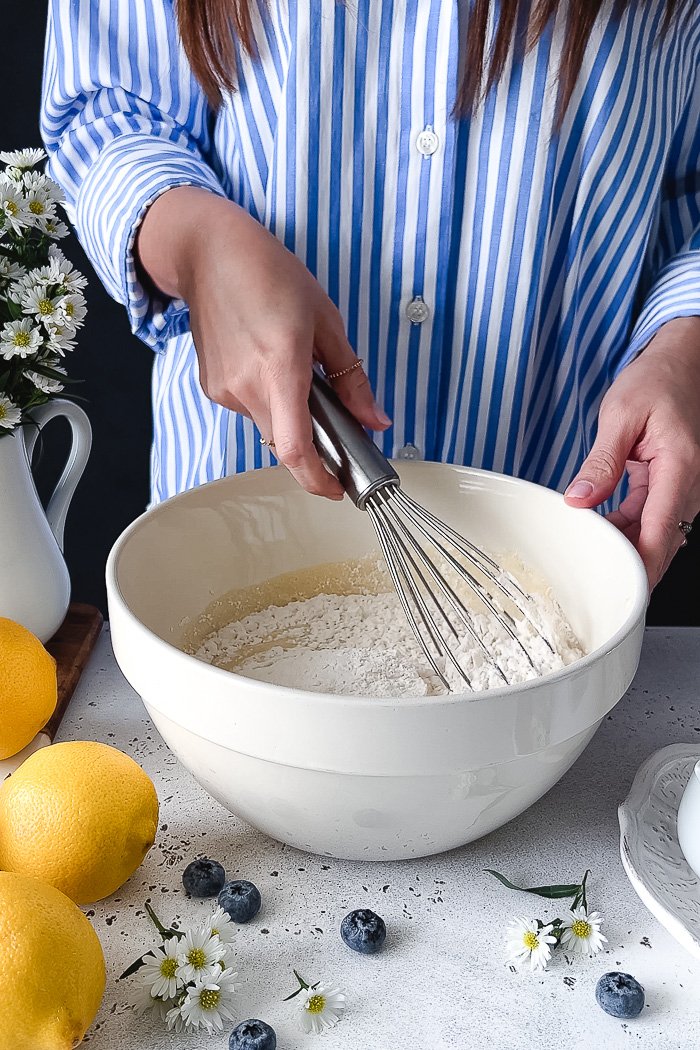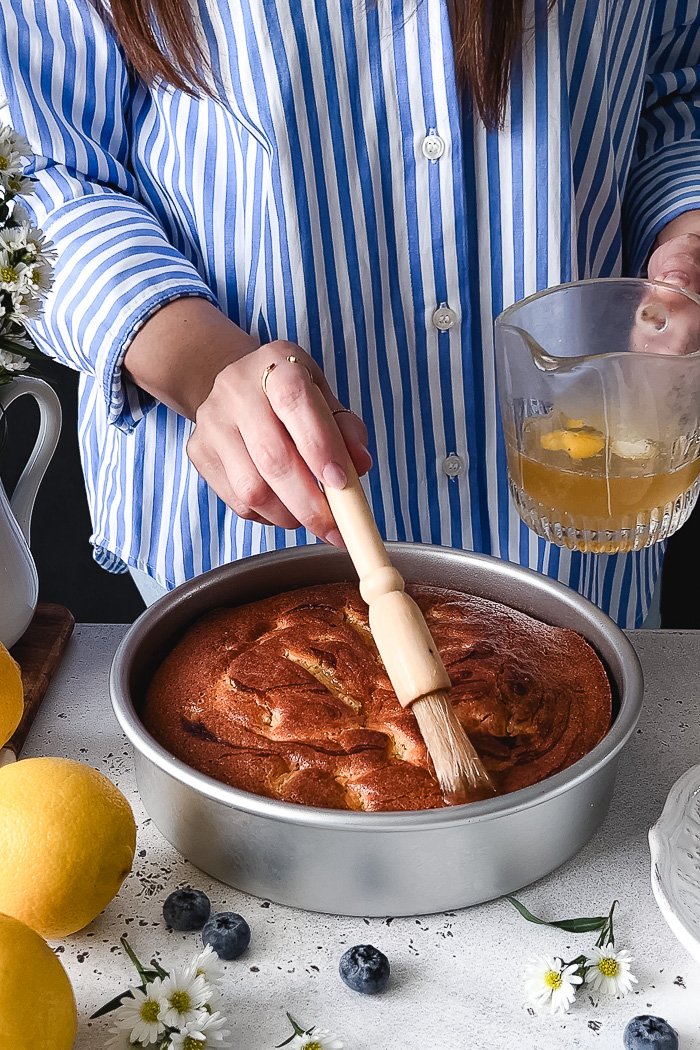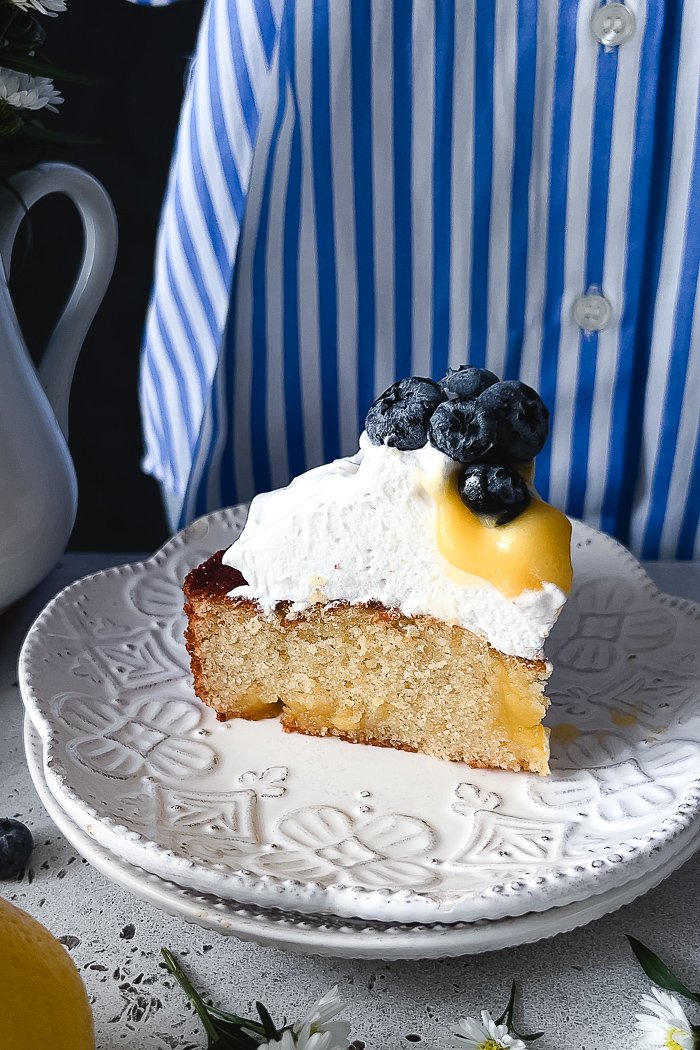Easy Lemon Olive Oil Cake with Lemon Curd and Meringue
(This post may contain affiliate links at no extra cost to you. This is my way to keep this site afloat and free of ads. Read my full disclosure here.)
Olive oil cakes are the best
This Lemon Olive Oil Cake is tender, soft and super moist. It’s a simple cake recipe that you can make in about an hour any time you are craving a sweet and easy bite. But the addition of the lemon curd in the batter and a crowning mellow meringue on top make this a showstopper for any special occasion! It’s simply a crowdpleaser!
If you have never baked a cake with olive oil, you are missing out badly! Baking cakes with olive oil is perfectly fine. You know I love olive oil cakes. The lightness and richness of the crumb makes it one the best cakes I’ve ever baked and eaten.
And when you add lemon juice to the cake batter, your cakes will be even more tender thanks to the lemon juice acidity breaking down the proteins in it.
Perhaps it’s that these two together are unstoppable. Because there are many flavor combinations that were created out of perfection. I mean, think about tomatoes and basil, apples and cinnamon, chocolate and milk. But nothing will put you heart at ease as lemon and olive oil can do. The two together work wonders in both sweet and savory creations. They’re united for the rest of history in so many recipes that their perfection together is undeniable.
What I really love is that such a strong and beloved combination is born from so simple and uncomplicated ingredients. The first time I made this cake was out of an empty fridge and sad pantry. I literally had 3 large lemons and no butter. But I knew olive oil would never fail me, and marvelous things happen when you believe!
How to make this Lemon Olive Oil Cake:
Start by making the lemon curd, which you can make many days in advance. Technically you can make half of the recipe here, but if you’re doing the work, it’s more fun to have some extra stored for pancakes, to fill cookies or to pour over cheesecakes. You can always leave it out, but it adds beautiful citrusy and creamy pockets that make this cake so delicious!
When is my lemon curd done? The lemon curd is done when the mixture doesn’t look foamy any more, it’s thick and a bit resistant when stirred and leaves a clear pass when you wipe the back of your spatula with your finger. But the best way to make sure not only that curd is done and safe to eat, but that it will keep a nice thick consistency is when the mixture reaches 180° in a candy thermometer. Clip it in your bowl and make sure it barely touches the bottom of it.
To keep up with the theme of the cake, I like to make the “buttermilk” by mixing lemon juice with milk for at least 15 minutes. If you have buttermilk at hand, just use that and omit the step of mixing the tablespoon of lemon juice with the ½ cup of milk.
Making the cake batter is extremely easy! Since the base of the cake is a sponge cake, you need to mix the eggs with the sugar in high speed until the mixture is pale and frothy. I prefer to do this in a stand mixer but you can use an electric hand mixer as well, just try to mix with even movements.
After you mix the wet ingredients you will add the dry ingredients at once and mix gently to prevent deflating the batter. Use the slowest speed in your mixer or use a hand whisk or wooden spatula and do it by hand.
Drop spoonfuls of the set lemon curd on top of the batter. Some will sink so spoon a bit more on top. Swirl delicately to prevent the curd mixing too much with the batter. Bake!
During the last 5 minutes of baking make the simple syrup to soak the cake by heating lemon juice and sugar. Brush it over the warm cake.
This cake can be eaten like that! But if you want to bring it up a notch, use the remaining egg whites from the curd to make an easy Italian meringue. That’s the only frosting you need for this cake! If making the curd in advance, store the egg whites in small freezer bags and freeze, When ready to use, submerge them in a bowl with hot tap water to thaw and follow the recipe accordingly. I love freezing egg whites, they work like a charm!
What you’ll need
A candy thermometer for making the curd and the meringue.
An 8” cake pan.
A reliable kitchen scale.
A beautiful and sturdy mixing bowl.
3 recipes I think you’ll love if you’re loving this one:
Lemon Basil Olive Oil Cake
Lemon Curd Cheesecake Tart with Basil Crust
Lemon Yogurt Cake
*
I know you’ll love this simple lemon olive oil cake! Can't wait to hear all about it!
Don’t forget to share and tag me in Instagram (@devamadeo), Facebook (@DevAmadeo) when you make it. Love to see my recipes in your kitchens!
(Remember to leave your email when you make a comment to receive a notification as soon as I get back to you. Don’t worry, this will not add your email to my email list.)
Easy Lemon Olive Oil Cake with Lemon Curd and Meringue
Ingredients
Lemon Curd Cake:
◯ Lemon juice – 1 TBSP, 15g
◯ Milk - ½ cup (or use buttermilk and omit the lemon juice)
◯ Cake flour, preferably (you may use all-purpose flour as well) – 1 cups, 150g
◯ Baking powder – ½ Tsp, 3g
◯ Fine sea salt – ½ Tsp, 3g
◯ Natural granulated sugar – ¾ cup, 150g
◯ Lemon zest – zest from 1 large lemon
◯ Large eggs, at room temperature – 2
◯ Extra Virgin Olive Oil – ½ cup, 110g
◯ Vanilla extract – 1 Tsp, 5g
Lemon curd:
◯ Whole organic eggs – 2
◯ Egg yolks – 2
◯ Natural granulated sugar – ¾ cup, 150g
◯ Lemon zest (optional for a stronger lemon flavor) - from 1 large or 2 medium lemons
◯ Freshly squeezed lemon juice – ½ cup, 115g
◯ Small pinch of salt
◯ Butter (if possible use an European style butter such as Kerrygold or a high fat content butter), cubed – 8 TBSP, 114g (½ cup or 1 stick)
Lemon soaking syrup:
◯ Freshly squeezed lemon juice - ¼ cup, 55g
◯ Natural granulated sugar - ¼ cup, 50g
Italian Meringue
◯ Egg whites - 2
◯ Water – ¼ cup
◯ Raw sugar – ½ cup
◯ Lemon - ½ Tsp, plus a slice to rub the bowl and attachment
Details
Yield:
an 8” cake pan
Total time:
1 hour 30 minutes
Active time:
20 minutes
Baking time:
25 minutes
Equipment:
stand mixer or handheld electric mixer, 8” cake pan, candy thermometer
Steps:
Making the lemon curd:
Fill by half a large skillet with water and bring it to a soft boil over medium low heat.
In a medium glass bowl whisk well the 2 eggs and the 2 egg yolks. Add the ¾ cup/150g of sugar, the lemon zest, the ½ cup/115g of lemon juice and the small pinch of salt until the sugar has dissolved.
Place the bowl on the skillet and using a wooden spoon or spatula stir slowly but almost constantly until the mixture thickens, this could take from 10 to 20 minutes. When the mixture heats it will produce some foamy white streaks. When those streaks disappear the curd should thicken up in the next 5 minutes. Keep moving until mixture thickens and has reached 180°. See notes above.
Retire from heat and strain through a sieve. Start adding the 8 tablespoons/114g of butter. Mix constantly until all the butter is melted. Keep mixing for an extra minute. Let it cool and then chill.
Use about half for the cake. Store remaining curd in an airtight jar or container in the fridge.
If making your own buttermilk:
Place the ¾ cup/150g of sugar in the stand mixer bowl. Zest the lemon and over it before using for the juice.
In a small bowl or measuring cup mix the 1 tablespoons/15g of lemon juice with the ½ cup/124g of milk. Let it rest for 15 minutes.
Making the cake:
Preheat oven to 350°. Grease with butter or line with parchment paper an 8” cake pan.
With a large sieve sift over a large bowl the 1 cups/150g of flour (cake or all-purpose), the ½ teaspoon/3g of baking powder and the ½ teaspoon/3g of salt. If you don’t have a large sieve, use a hand whisk to mix for a couple of minutes.
If you haven’t already, place the ¾ cup/150g of sugar with the lemon zest in the bowl of the stand mixer. Using the whisk attachment mix for 2 minutes in the slowest speed.
Add the 2 eggs and mix for 5 minutes in high speed (level #8 in the Kitchen Aid). Mixture should become light pale a foamy.
With the mixer running, start drizzling slowly the ½ cup/110g of olive oil in a thin stream. Mix for 2 minutes. Decrease speed to the lowest and add the lemon juice-milk mixture or buttermilk and the teaspoon/5g of vanilla. Add the flour mixture and using a hand whisk mix gently just until combined.
Pour batter into pan. Swirl about half of the lemon curd over the batter. Bake until a toothpick comes out clean after you inserted it through the center, 20 to 25 minutes. Pour soaking syrup (recipe follows) and let it cool down a couple of minutes before releasing from pan. Let it cool down completely before placing meringue on top.
Making the lemon soaking syrup:
While the cakes bake, combine the ¼ cup/55g of lemon juice and ¼ cup/50g of sugar. Bring to a simmer or gentle boil. After sugar has dissolved, cook for 1 to 2 minutes, swirling frequently.
Remove from heat and using a pastry brush or small spoon pour the syrup evenly through the cake. Let them cool down completely.
Making the meringue:
Make sure that the mixer bowl and the wire accessory are very clean and free of any grease residue. Any fat will prevent the egg whites from rising. Move the mixer as close to the stove area as possible.
In a small saucepan pour the ¼ cup of water. Add the sugar in the middle to prevent granules sticking on the saucepan walls.
Rub the bottom, the sides of the bowl and the wires of the whisk with a lemon cut in half. Drop the ½ teaspoon of lemon juice. Add the 2 egg whites and ¼ teaspoon of the cream of tartar. Beat on low speed for 30 seconds to distribute everything. Increase speed to medium (#4 in the stand mixer) and beat until soft peaks form.
Immediately start heating the sugar and water on high heat until a candy thermometer reaches 240°. Be stand by as soon as it goes beyond 225°.
As soon as it reaches 240°, remove from heat and in a thin but continuous stream pour the syrup over the egg whites with the mixer still running (try to prevent pouring sugar too near to the edge). Beat for 2 minutes then increase speed to medium-high (#6 in the stand mixer). Beat for an additional 3 to 4 minutes, until the bowl feels at room temperature on the outside.
Decorate creating soft peaks or waves with a silicone spatula or upside-down spoon. You have to work the meringue relatively quick, it will look a bit broken if smeared when it’s already too cooled down, even if it’s completely safe to eat.










